It is quite common for travellers to buy gems or finished jewellery during a trip. Often price and selection are better in places where stones are mined, cut or set than elsewhere. Some caution is required since a few vendors are positively predatory, especially in heavily touristed areas. Bargaining is sometimes needed to get a good price, even from an honest vendor.
Some travellers also dig up gems themselves; see Rockhounds.
Understand
As with any goods that span a wide range of prices, it is safer to avoid the big-ticket items unless you are either an expert yourself or have expert advice, dealing with a large reputable vendor will reduce the risk, and "tourist trap" stores should be avoided. See shopping for other general advice.
It does not always apply, but the phrase "touchstone markup" is used in the gem trade. That is a 100% markup; the price will double for every set of hands the stone passes through. Sometimes this means that the price difference between buying at or near the source and buying elsewhere is enormous.
If you plan to bring home expensive jewellery, check your country's import regulations. Some countries, such as Canada, charge a stiff duty on finished jewellery but much less on unmounted stones. In those cases it may be better to buy cut and polished but unmounted stones and have a craftsman back home mount them.
Pricing
Stones are sometimes classified as precious (diamond, ruby, sapphire and emerald) or semi-precious (everything else) and prices generally reflect this, though a good semi-precious stone will often cost more than a low-grade precious one.
 Both the quality and the size of stones can greatly affect their price; stones that are either flawless or large may be rare and expensive. Colour is also often a factor; many gems come in a range of colours depending which impurities are present. Murkiness, inclusions (dark or opaque areas within the stone), or flaws (cracks, empty spaces, crystal boundaries if the stone is not from a single crystal, or other irregularities) can greatly reduce the value of a stone. Pointing these out may be helpful in bargaining.
Both the quality and the size of stones can greatly affect their price; stones that are either flawless or large may be rare and expensive. Colour is also often a factor; many gems come in a range of colours depending which impurities are present. Murkiness, inclusions (dark or opaque areas within the stone), or flaws (cracks, empty spaces, crystal boundaries if the stone is not from a single crystal, or other irregularities) can greatly reduce the value of a stone. Pointing these out may be helpful in bargaining.
Stones are generally priced by weight, measured in carats; five carats is one gram. Within the range of common sizes, the weight/price relation is linear; if — for some particular gem, colour and quality grade — a 1-carat stone is $100 then a 10-carat stone will be about $1000, provided such stones are reasonably common. Outside that range, the sky's the limit. If, for some other gem, stones above 5 carats are rare then a 10-carat stone may be considerably more than $1000 and the price of a 20-carat stone is likely to be astounding. A really large stone might be sold at an auction where only museums and millionaires could afford to bid.
If one stone is just a scaled-up version of another (multiply length, width and depth by the same constant), then the volume and weight are proportional to the cube of the diameter. A stone that is twice the diameter of another will then be about eight times the weight and price. Of course this is not always the case; a larger stone may be cut proportionally thinner (less depth) than a smaller one.
Several smaller stones in a piece of jewellery may be a better buy than one large one; for example it is common to see three sapphires in a row across a ring. Three stones of 5mm diameter will often have total weight, and therefore cost, considerably less than a single 8mm stone (35<sup>3</sup> = 375 is less than 8<sup>3</sup> = 512), but the total surface area they display will be slightly larger (35<sup>2</sup> = 75 is more than 8<sup>2</sup> = 64). Also, smaller stones are more likely to be flawless; a cutter working on a raw stone that has a flaw might either produce a large but flawed finished stone or cut around the flaw to get several smaller unflawed stones.
Hardness
 There is a scale for the hardness of minerals, with various minerals used to define the levels. The top four are diamonds 10, corundum (sapphires and rubies) 9, topaz 8, and quartz 7. Any of these are hard enough for any use; in particular they can be used in a ring with no fear of damage if the hand bangs against something.
There is a scale for the hardness of minerals, with various minerals used to define the levels. The top four are diamonds 10, corundum (sapphires and rubies) 9, topaz 8, and quartz 7. Any of these are hard enough for any use; in particular they can be used in a ring with no fear of damage if the hand bangs against something.
Rose quartz, clear "rock crystal", citrine (yellow or brown) and amethyst (purple) are varieties of crystalline quartz, with different colours from different impurities. Agate and jasper are mostly quartz and have hardness 6.5 to 7. Other hard stones — such as beryl (7.5–8) including emeralds, spinel (7.5-8), tiger eye (7) or garnet (6.5–7.5) — can also be used anywhere.
Stones with hardness below 5 should be used only where they are unlikely to get banged about, in particular never in rings. Examples include flourite (4), pearls (2.5–4.5), coral (3–4), malachite (3.5–4), rhodochrosite (3.5–4) or amber (2–2.5).
Moderately hard stones — moonstone (6-6.5), opals (5.5–6.5), turquoise (5–6), labradorite (6–6.5), sodalite (5.5–6), diopside (5–6), lapis lazuli (5–6) and obsidian (volcanic glass, non-crystalline quartz) (5-5.5) — are less than ideal for rings or bracelets; they are fairly often used in those, but there is some risk they will scratch, chip or crack if they hit something. It is safer to get them in some other piece of jewellery; earrings and pendants are popular choices. The shape of the stone and the design of the setting affect the risk; a stone that sticks out is much more likely to be damaged than a flat one or one protected by the setting.
Stones
Gems are found all over the world, but some places are famous for certain types.

-
Moonstone. Moonstones come in many varieties; the top grades are clear and lower grades murky or with inclusions. Sri Lanka is the largest source of the stone today and has plenty of the most sought-after type, a clear bright blue-white, but many other colours can be found as well. India also has moonstones, including many that are less clear or in other colours but still beautiful and often available at better prices or in larger sizes.
-
Emeralds. These are a variety of the mineral beryl, as are aquamarine and red beryl; what sets emerald apart is trace amounts of impurities that give it an intense green colour. Today Colombia produces more than half the world emerald supply and Zambia is second with about 20%. Historically, Egypt and India were important sources but they are no longer major players.
-
Diamond. Diamonds are the most highly compressed form of elemental carbon. They are most commonly colourless, but trace impurities can result in coloured diamonds which are even more expensive due to their rarity. The gem has a high index of refraction so, if properly cut, they sparkle extremely well.
They are mined mainly in South Africa and nearby countries and kept artificially expensive by the De Beers monopoly and other organizations that engage in price fixing in cooperation with them. Diamonds are among the most common gemstones on Earth and are often produced industrially, though those on sale for engagement rings and so forth are normally mined. If you choose to buy jewelry made with them, it may be best to do so in places where they are cut; see Diamond rings in Antwerp. Processed diamonds are one of Israel's main exports despite Israel having little to no diamond mining.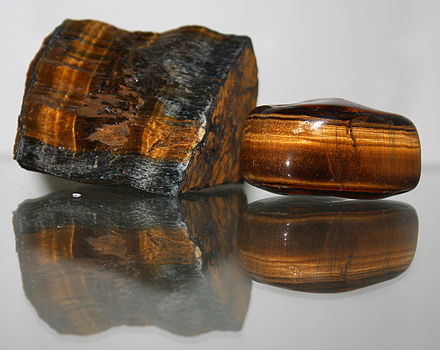
-
Tiger eye. This stone is found in many countries. The most common colour combination is a mix of gold and brown, second commonest blue stones sometimes called "hawk's eye." Red is rare as a natural colour, but red stones can be produced by heat treating brown stones.
-
Opal. Australia produces most of the world's opals; the largest mine is in Coober Pedy but opals are available in any of the main cities. Other towns famous for opal include Lightning Ridge and White Cliffs in northwestern New South Wales and Andamooka, South Australia.<br/>Mexico is another source for opals. known for "fire opals" which have the iridescence of an opal, but with background colours other than white; red and black are commonest.
-
Garnet. Garnet has been used as a gemstone since the bronze age, and was the most common gemstone in the late Roman Empire. Most garnets are red, but see below for green demantoid garnet.
-
Diopside. Diopside is found around the world and in a wide range of colours. Among the better-known varieties are green diopside, found in Finland, Italy and other places, and the "black stars" which are common in India. The region around Lake Baikal has both green and blue stones, and Baffin Island has violet ones.
.jpg/440px-Gemstone_Collection_-_Labradorite_(17278919981).jpg)
-
Labradorite. Labradorite is named for the Canadian region Labrador and is still mined there, but today the main source is Madagascar. It is an iridescent stone, most commonly dark blue but also found in other colours.
-
Turquoise. Turquoise is mined in several parts of the world, notably Iran, Sinai and parts of the United States, including Arizona, Nevada, and New Mexico. When buying turquoise, you should understand what treatments it has been subjected to. Oil is generally unobjectionable, as is mounting a thin veneer of real turquoise on a stronger backing, but some treatments – dyeing, bonding, stabilization, and especially reconstitution (little bits of turquoise dust glued together) – substantially damage the gemstone's value.
-
Hematite (bloodstone). Hematite comes in a variety of colours, most commonly red or black. It is often mined as an iron ore and can also be used as a gem. It is a common mineral found in many places, such as around Lake Superior and in volcanic areas such as Yellowstone.

-
Lapis lazuli. Ancient Badakhshan was trading lapis lazuli before 3000 BCE, and Badakhshan province of Afghanistan is still producing it. Today Chile is the other main source, and Russia produces some near Lake Baikal. The usual colour is a rich deep blue and there are often pyrite inclusions whose golden yellow contrasts beautifully.
-
Spinel. Spinel is another gem that Badakshan traded in ancient times, and even today the Gorno-Badakhshan region of Tajikistan is still the main source. It is often red, and until modern chemistry made the differences clear, many spinels were called rubies. Several famous "rubies", including the Black Prince's Ruby among the British Crown Jewels, are actually spinels.
-
Sodalite. Sodalite is sort of the poor man's lapis lazuli, another mineral which is usually a lovely shade of dark blue and hard enough at 5.6-6, but somewhat fragile, without the pretty inclusions, and usually cheaper.
-
Obsidian (volcanic glass). Obsidian is an amorphous (non-crystalline) quartz mineral. Hardness is 5 to 5.5, lower than other forms of quartz, and like any glass it is quite brittle. The commonest colour is black, but there is a range of colours and some stones have a mixture. It is found in many places near volcanoes; there is a lot of it near the ancient Yellowstone supervolcano. There is evidence of its use in tools by early humans as far back as 700,000 BC.
-
Rhodochrosite. Rhodochrosite is most often pink but red is also common, and yellow, grey or brown are sometimes found. It is Argentina's national gemstone and Colorado's state mineral; the main mines are near Capillitas (Catamarca) and Alma (a village near Denver) respectively. It is also mined in Romania, China and other US states.
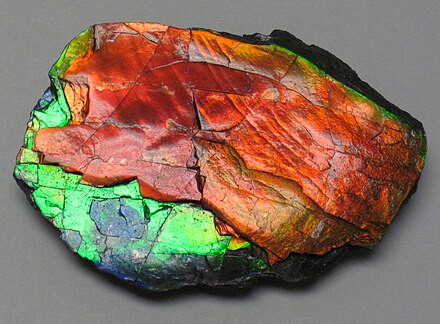 A few types of gemstone are found only in quite limited areas. They are likely worth looking for if you travel there.
A few types of gemstone are found only in quite limited areas. They are likely worth looking for if you travel there. -
Tanzanite. Tanzanite is found only in one small area in Northeast Tanzania. It shows three colours — blue, violet and burgundy — changing with the angle of view and the lighting.
-
Ammolite. Ammolite is found only along the eastern side of the Rocky Mountains, mainly in Alberta and Montana. It is formed from ammonite fossils and is often very pretty, multi-coloured and irridescent.
-
Demantoid garnet. This is the most valuable variety of garnet, bright green. It is found in only a few places, all near Yekaterinburg in Russia's Ural mountains.
See pearls below for other items found in only a few places.
Rubies and sapphires
 Rubies and sapphires are the same mineral, corundum (hardness 9); different impurities give different colours. Red ones are called rubies; any other colour is a sapphire, but the most prized sapphires are intensely blue. The top-grade stones are very clear and can be cut with facets; lesser stones are cut cabuchon (curved, not faceted) to give star rubies or star sapphires.
Rubies and sapphires are the same mineral, corundum (hardness 9); different impurities give different colours. Red ones are called rubies; any other colour is a sapphire, but the most prized sapphires are intensely blue. The top-grade stones are very clear and can be cut with facets; lesser stones are cut cabuchon (curved, not faceted) to give star rubies or star sapphires.
Sri Lanka is known for sapphires, Myanmar for rubies, and India has some of both. There are also rubies in Greenland and Nunavut.
Off-color stones — most commonly grey, but also burgundy, pale blue, pink or brown — are much cheaper than bright red or blue stones and may still be lovely. Burgundy "plum stars" are common in Agra; they usually have a lot of inclusions (about a third of the stone is black), but they can be quite pretty and are remarkably cheap compared to other rubies. Sri Lanka has many grey star sapphires, also relatively cheap.
Black or green star sapphires are rare and command a high price; they have a six-point star like any other sapphire. A "black star" which has only four points is a semi-precious stone called diopside, and should be far cheaper. Some vendors may try to sell tourists black stars at sapphire prices; walk away quickly.
Historically, some red spinels were also called rubies, but gemologists now reserve the term "ruby" for red corundum.
Jade
Jade has been an important stone in many cultures throughout history. It is used not only in jewellery, but also in carvings, statues, tools, weapons and even for household objects like bowls. The Liangzhu Culture in China (3400-2250 BCE) is known mainly by the high-quality jade artifacts it left behind, and many other groups — especially other parts of China, Southeast Asia, Mexico and Central America, and the Maori of New Zealand — used jade.
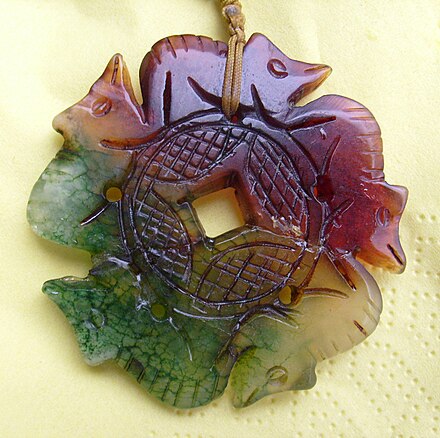 There are two distinct minerals that are called jade; nephrite is more common, jadeite often more valuable. Most Chinese and all Taiwanese and Canadian jade is nephrite; most Burmese jade is jadeite.
There are two distinct minerals that are called jade; nephrite is more common, jadeite often more valuable. Most Chinese and all Taiwanese and Canadian jade is nephrite; most Burmese jade is jadeite.
- Maritime jade route. There was extensive trade in jade — mainly mined in Taiwan and processed in the Philippines — among the Austronesian peoples of Southeast Asia, starting around 2000 BCE and continuing to after 500 CE. There are still some good Chinese sources for jade, notably Khotan, but today most of the best jade in China is imported from Myanmar (Burma). The border town Ruili has much jade, but for the best deals, go to Myanmar. Taiwan also continues to produce some jade, with much of the mining being concentrated in the area around Hualien, and numerous jade shops in the city where you can purchase local jade products.
In Myanmar, the city of Mandalay has a jade market where you can watch merchants haggling over the price of jade at all stages of production. You can even purchase some jade trinkets yourself, but be prepared to haggle, and if possible do some homework beforehand to have some idea what prices should be.
British Columbia (Canada) is also famous for jade; the sprawling Jade City store on the Stewart-Cassiar Highway in northern BC is a great experience for jade fans, but you can find better deals in Vancouver.
There are other stones which may be used instead of jade, including serpentine or "false jade" and "greenstone", a general term applied to several different minerals.
Pearls
Almost every tropical seacoast area has some pearls, hard objects produced by various aquatic mollusks. Places known for their pearls include Tahiti, Bahrain, Mexico, India, Indonesia, Myanmar and the Philippines.
Pearls are not hard enough for all applications; the most common uses are in necklaces and earrings. Good pearls are not cheap, but they are much less than some other gems; a fine pearl necklace will be expensive, but one with the same number and size of emeralds might bankrupt a small country.
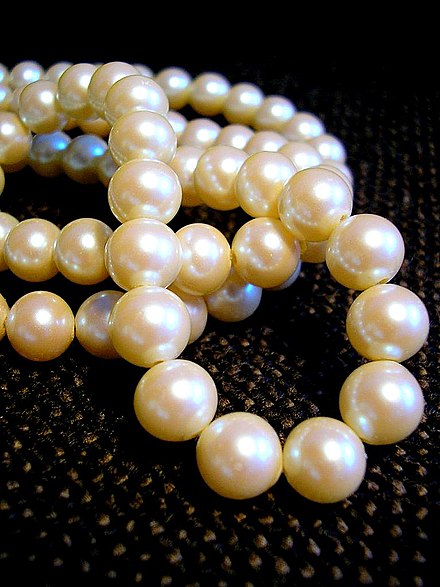 The best-known type is produced by various species of oysters and made of a substance known as nacre or mother-of-pearl, giving it its distinctive iridescent appearance. Natural pearls are rare and expensive; the vast majority of pearls on the market today are cultured pearls, made using a technique which originated in Japan but now produced in many other countries.
The best-known type is produced by various species of oysters and made of a substance known as nacre or mother-of-pearl, giving it its distinctive iridescent appearance. Natural pearls are rare and expensive; the vast majority of pearls on the market today are cultured pearls, made using a technique which originated in Japan but now produced in many other countries.
China has freshwater pearls, made by a species of freshwater mussels, and usually cheaper than saltwater pearls. These are also made of nacre.
There are several types of pearl not made of nacre:
- The conch pearl — produced by the queen conch, a marine mollusk found only in the Caribbean, in particular the Bahamas — comes in various colours. The most highly-prized ones are pink and porcellaneous, with a distinctive "flame structure" appearance that resembles a fire burning on the surface.
- The melo melo pearl, made by the melo melo snail, which is found in the South China Sea and Andaman Sea, in the waters off the coasts of the Philippines, Vietnam, Cambodia, Thailand, Malaysia, Indonesia and Myanmar. Like the conch pearl, the most prized ones have a porcellaneous "flame structure" on the surface, but they are orange instead of pink.
- The quahog pearl is produced by a species of clam found off the east coast of Canada, the United States of America and Mexico, with the most prized ones having a purple hue.
Unlike oyster pearls, these have never been cultivated, so they are rare and expensive.
Mother-of-pearl
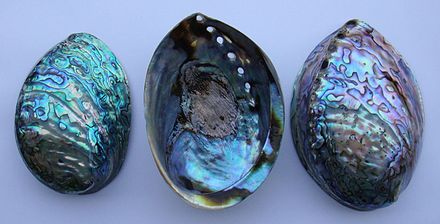 "Mother-of-pearl", the lining of mollusk shells (including some from species that do not produce pearls), is also used in various decorative arts including jewellery. Large pearls are rare and expensive, but it is relatively easy to get a large chunk of mother-of-pearl; just find a big shell and cut it to suit the requirement.
"Mother-of-pearl", the lining of mollusk shells (including some from species that do not produce pearls), is also used in various decorative arts including jewellery. Large pearls are rare and expensive, but it is relatively easy to get a large chunk of mother-of-pearl; just find a big shell and cut it to suit the requirement.
New Zealand has a famous variety of mother-of-pearl which is mostly blue and often iridescent, from an abalone called paua which is found only in NZ; both paua jewellery and other items inlaid with paua are popular souvenirs.
Museums
Almost any natural history museum worldwide will have a geology section, often including some gems. Some mines and many mining towns or regions also have museums with gems.
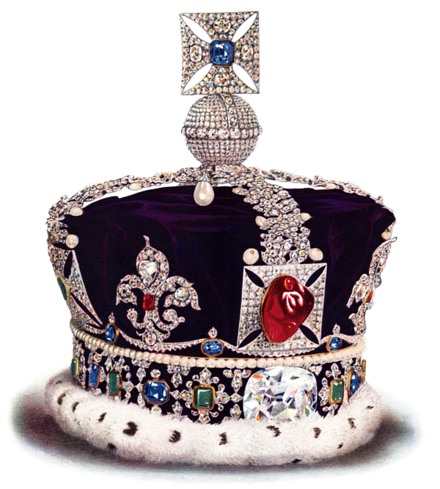 Some famous gems are in museums:
Some famous gems are in museums:
- British Crown Jewels. This collection includes many fine gems, mostly collected (some would say stolen) in the days when the British Empire ruled much of the world.
- Cullinan Diamond (Star of Africa). At over 3000 carats before cutting this is much the largest gem-quality diamond ever found; it was cut into over 100 stones. The two largest — the 530-carat Great Star of Africa (Cullinan I) and 317-carat Second Star of Africa (Cullinan II) — and many of the others are among the crown jewels.
- Black Prince's Ruby. This 170-carat red spinel (technically not a ruby), probably from Badakhshan, has belonged to the royal family since 1367.
- Saint Edward's Sapphire. Named for Edward the Confessor, the king of England 1042–1066, later canonized.
- Koh-i-noor (Mountain of light). This 105-carat diamond came to Queen Victoria as spoils from an Anglo-Sikh War in the 1840s, and is still among the crown jewels. A historical novel about the period, featuring the diamond, is Flashman and the Mountain of Light.
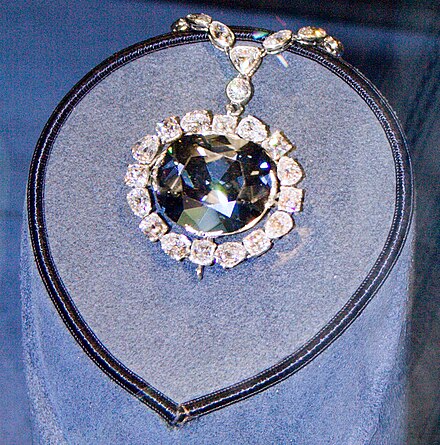
- National Gem and Mineral collection, National Mall, Washington DC. This has a fine collection of minerals including many gems. It also has a remarkable collection of meteorites. It is part of the Smithsonian in Washington, D.C.
- Hope Diamond. A blue 45-carat diamond, found in India in the 17th century.
- Star of Asia. A 330-carat star sapphire.
- Regent Diamond (Pitt Diamond). This 105-carat (cut) stone was found in India around 1700.
- Three Treasures of the National Palace Museum. Two of the three treasures from the collections of the emperors of China were carved out of gemstones, while the third is a vessel made of bronze.
- Jade Cabbage. Carved out of a half-white, half-green piece of jadeite, with a locust and a katydid camouflaged in the leaves.
- Meat-Shaped Stone. Carved out of banded jasper to resemble a piece of braised pork belly.
Ethical concerns
See also: Responsible travel
There are two important ethical concerns you might consider in regard to buying gemstones.
The first is the destructiveness of mining practices. For example, some diamond mines are of the open pit variety, which can cause irreversible environmental damage. In other places, mine safety is a serious problem. Some gems, such as quartz, may be mined by families digging deep in the dirt without any safety equipment or any way to prevent the tunnels from collapsing. What they dig out is usually sold for a pittance to distributors, who then sell the stones at a much higher price to wholesalers and tourists.
The second is that the value of the gemstones has made mines attractive to governments, terrorist groups and criminal organizations that use the profits they receive from the sale of these stones to finance brutality, torture, murder and other crimes against humanity. There have been some efforts to combat what are called blood or conflict gemstones and diamonds, but due to the lucrativeness of the industry, these are often smuggled across borders and find their way onto the markets of wealthy countries, anyway.
Stay healthy
You should avoid wearing gemstones and crystals with magnetic charges if you have implanted medical devices such as pacemakers and defibrillators as they may interfere with these devices. Magnetic gems include magnetite, hematite, shungite and pyrrhotite. Watch out for any stone which contains iron.
Working with some gems can be hazardous. Malachite, for example, contains mercury and can emit dangerous fumes when being cut or polished. Like any heavy metal poison, mercury generally causes no obvious immediate symptoms but it remains in the body indefinitely and can cause long-term damage. Wearing malachite jewellery, though, is entirely safe.